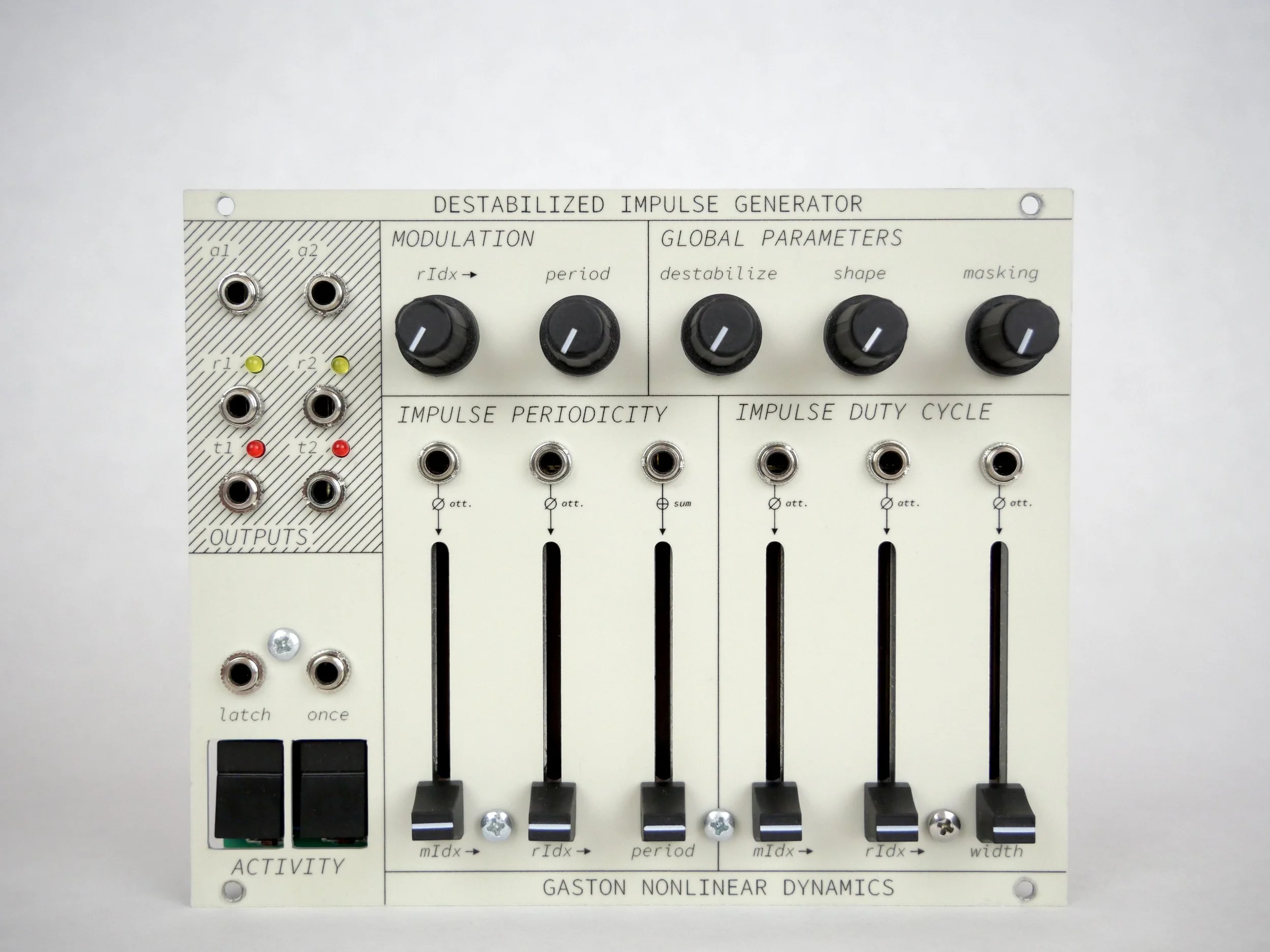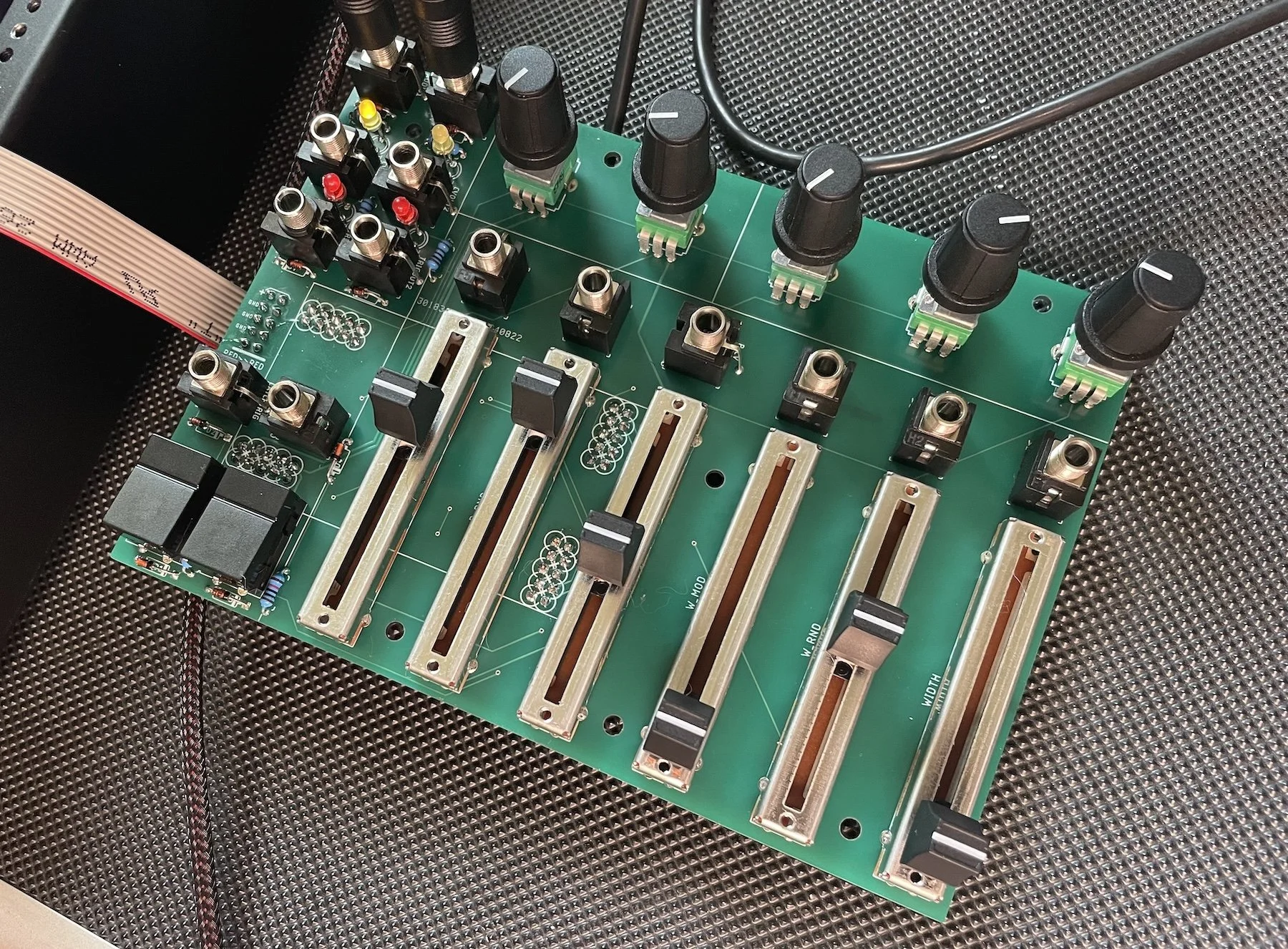Destabilized Impulse Generator (2024)
Destabilized Impulse Generator prototype
Destabilized Impulse Generator is a concept/prototype module for the [Nonlinear] Dynamics system. It is now considered obsolete—its core functionality is replicated and extended in the more recent Compact Impulse Generator. As of May 2025, only two Destabilized Impulse Generators have been built; nonetheless, it marks a significant milestone in developing the [Nonlinear] Dynamics system.
Preamble
In late Spring of 2024, I “designed” a module called Test—a generic, general-purpose breakout board for the Electrosmith Daisy Patch Submodule. Test was designed to accommodate rapid prototyping of concepts for Eurorack modules. Once it was up and running, it became evident that my workflow of choice—programming the PatchSM via Max [gen] and [oopsy]—was much faster and more effective than I had anticipated. As such, I almost immediately began development of several prospective hardware devices, of which Destabilized Impulse Generator was the first. Despite having used Max for over a decade, until the release of the PatchSM, I had never gotten deep in to [gen~]; however, Graham Wakefield and Gregory Taylor’s excellent book Generating Sound & Organizing Time and the hardware development opportunities presented by the Daisy gave me the nudge I needed to dive in.
Some of my first projects in [gen~] included the implementation of nonlinear waveshaping structures similar to those that I had recently developed for the map01 and map02 Delta Scan Mapping Generators (which had been realized primarily with PJRC’s Teensy audio library). The more rapid rate of experimentation afforded by the Max environment (with which I was considerably more familiar) led me to try many different waveshaping tricks and unusual structures. Previously, I had primarily focused on digital waveshaping in feedback systems and in more traditional “oscillator” contexts, in the vein of the Buchla 360, Touché, 400, etc. However, it quickly became clear to me that there was tremendous overlap between digital nonlinear waveshaping and pulsar synthesis. From there, my work with digital nonlinear waveshaping went in two primary directions—ultimately leading toward the Compact Oscillator Network (inspired by the Buchla 360 and Touché), and the Destabilized Impulse Generator/Compact Impulse Generator, inspired by the work of Curtis Roads (whose music was deeply influential in my life c. 2006).
Around this time, Sarah Belle Reid and I had been asked to create a new piece of music for the CLEAT system at Elastic Arts in Chicago. CLEAT (Chicago Laboratory for Electro-Acoustic Theater) maintain a rather unusual 16-channel speaker system, currently installed in a 4x4 grid along the ceiling of Elastic Arts. Each speaker is more or less omnidirectional, resulting in unique sound diffusion opportunities. Experimenting in the space in June 2024, it became clear that particle-based sound generation methods were especially interesting in this particular sound system; as such, I began to focus more intently on developing a pulsar synthesis patch in [gen~]—partly as a learning exercise, partly as a next step for hardware development, and partly so that, when it came time to present our new piece for the CLEAT system in October 2024, I would have an instrument to play.
Destabilized Impulse Generator, freshly assembled—August 27th, 2024
I spent the summer of 2024 developing several module concepts in [gen~]—Destabilized Impulse Generator being principal among them. I ordered PCBs in late summer, and had assembled the first prototypes by August 27th. A second Destabilized Impulse Generator and early version of the Voltage Mapping Array made it to the performance at CLEAT, as shown in the video above.
Functional Description
Destabilized Impulse Generator is a monophonic sound generator based on the concepts of pulsar synthesis. It is inspired in equal parts by music and design concepts by Curtis Roads, Rob Hordijk, and Donald Buchla. Though it does feature control voltage inputs and outputs, it was important to me that Destabilized Impulse Generator be able to stand on its own as a complete instrument—one which could hold up in improvised music contexts.
As such, I looked to devices like Hordijk’s Blippoo Box and Benjolin—each of which have had a significant influence on my overall design aesthetic. Like these devices, Destabilized Impulse Generator features extensive internal modulation and many user controls dedicated to restructuring the internal modulation path. Ultimately, this facilitates the intuitive and spontaneous creation of self-sustaining, chaotic, and surprising sound structures. These span from drones and sporadic impulse trains to dense, abrasive textures to sparse, wispy flickers and discontinuous clicks.
The core of Destabilized Impulse Generator is a variable-frequency, variable-width ramp generator. The ramp generator is used to “scan” a programmatically-defined nonlinearity—essentially, a lookup table with sixteen selectable waveshapes, selected using the Shape control. By altering the ramp generator’s Period duration and Width, we can approximate Curtis Roads-like pulsar synthesis—although it should be noted that, in Destabilized Impulse Generator, the apparent “formant frequency” is linked to both the width and period controls.
The Masking Pattern parameter is divided into five distinct ranges, each of which represents a unique algorithm for determining the distribution of sound between the device’s A and B audio outputs. By performing different sorts of amplitude masking on each output, it is possible to achieve many different dynamic profiles and stereo panning techniques. Within each of the five ranges, the Masking Pattern knob applies continuously variable control to one or more aspects of the Masking Pattern in question—turning the knob allows you to access a large number of dynamic structures. In use, precision is not expected—a user can generally expect that turning the Masking Pattern knob to any position should produce interesting results. Over time, of course, one develops an understanding of how different regions of the knob tend to impact the module’s global behavior. Notably, the Masking Pattern settings also determine the synchronization method and update rate for five random number generators—one of which can be applied to the Period parameter, one of which can be applied to the Width parameter, one of which may impact the rate of an internal modulation oscillator, and two of which appear as control voltage outputs on the panel. Likewise, the module’s two timing pulse outputs are derived from the Masking Patterns’ synchronization processes.
As mentioned above, Destabilized Impulse Generator contains a modulation oscillator, which may be used to impact the Period and Width of the ramp generator. The modulation oscillator always produces a sine wave.
The Destabilize parameter introduces phase and frequency modulation feedback into various aspects of the device’s general structure. In the lower half of its travel, it tends to emphasize low frequencies and apply a rubbery distortion to the current waveform; beyond 50%, though, it introduces extreme high-frequency oscillations, sputters, and significantly nonlinear behaviors.
One may think of Destabilized Impulse Generator as being similar to a “complex oscillator” in the style of many Buchla inventions: it has a principal oscillator (the ramp generator), a modulation oscillator, and a waveshaper. However, in practice, it diverges considerably in sound and behavior from these other devices, and is somewhat more similar to a Benjolin or Blippoo Box. Especially once Destabilize is engaged, the apparent function of any given control becomes less clear: it becomes possible for any given knob to take on the appearance of a highly complex, global behavior control. This is one of the the device’s strengths: it can be quite unclear how any particular approach to interaction will unfold in performance, leading to a general state of careful listening and surprise.
As the [Nonlinear] Dynamics system developed, it became apparent that Destabilized Impulse Generator’s parameterization was relatively inefficient, and its use of the Daisy PatchSM hardware was somewhat suboptimal. As such, it was redesigned in February 2025 and renamed Compact Impulse Generator (a name owed, in part, to its reduced size and streamlined parameterization).
Destabilized Impulse Generator was developed for personal use and is not available for sale.

